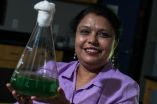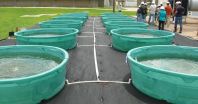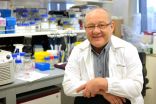The findings, which are based on a five-month study at a wastewater treatment facility in Houston, are available online in the journal Algae.
"Biofuels were the hot topic in algaculture five years ago, but interest cooled as the algae industry moved toward producing higher-value, lower-volume products for pharmaceuticals, nutritional supplements, cosmetics and other products," said study lead author Meenakshi Bhattacharjee, a 28-year veteran of algal research who joined Rice's biosciences faculty in June. "The move to high-value products has allowed the algaculture industry to become firmly established, but producers remain heavily dependent on chemical fertilizers. Moving forward, they must address sustainability if they are to progress toward producing higher-volume products, 'green' petrochemical substitutes and fuels."
Bhattacharjee said the algae industry's reliance on chemical fertilizers is a double whammy for algae producers because it both reduces profit margins and puts them in competition with food producers for fertilizers. A 2012 National Research Council report found that "with current technologies, scaling up production of algal biofuels to meet even 5 percent of U.S. transportation fuel needs could create unsustainable demands for energy, water and nutrient resources."
The 2012 report also pointed to wastewater-based cultivation as a potential way to make algae production sustainable. An added appeal is that the method could potentially address a looming environmental problem: nutrient pollution in U.S. waterways. According to the Environmental Protection Agency, nutrient pollution from excess nitrogen and phosphorous -- the two primary components of chemical fertilizers -- is "one of America's most widespread, costly and challenging environmental problems."
Wastewater treatment facilities currently have no cost-effective means of removing large volumes of nitrates or phosphorous from treated water, so algae production with wastewater has the potential of solving two problems at once, said study co-author Evan Siemann, Rice's Harry C. and Olga K. Wiess Professor of BioSciences.
"The idea has been on the books for quite a while, but there are questions, including whether it can be done in open tanks and whether it will be adaptable for monoculture -- a preferred process where producers grow one algal strain that's optimized to yield particular products," he said. "We were surprised at how little had been done to test these questions. There are a number of laboratory studies, but we found only one previous large-scale study, which was conducted at a wastewater facility in Kansas."
Siemann said the Rice study was made possible by the participation of the Houston Department of Public Works and Engineering, which helped Rice's research team set up a test involving 12 open-topped 600-gallon tanks at one of the city's satellite wastewater treatment plants in July 2013. The tanks were fed with filtered wastewater from the plant's clarifiers, which remove suspended solids from sewage. Various formulations of algae were tested in each tank. Some were monocultures of oil-rich algal strains and others contained mixed cultures, including some with local algal strains from Houston bayous. Some tanks contained fish that preyed upon algae-eating zooplankton.
"Prior research had suggested that diverse assemblages of algal species might perform better in open tanks and that fish might keep algae-eating zooplankton from adversely affecting yields," Siemann said.
"We recorded prolific algal growth in all 12 tanks," he said. "Our results are likely to be very encouraging to algae producers because the case they would prefer -- monocultures with no fish and no cross-contamination -- was the case where we saw optimal performance."
Bhattacharjee said more research is needed to determine whether wastewater-based algaculture will be cost-effective and under what circumstances. For instance, the algae in the Rice study was four times more effective at removing phosphorous than were the algae in the Kansas study. She said that could be because the Houston test was performed in summer and fall, and the tanks were about 30 degrees warmer on average than the tanks in Kansas.
"Using wastewater would be one of the best solutions to make algaculture sustainable," she said. "If temperature is key, then cultivation may be more economical in the Southeast and Southwest." She noted that other factors, like starting levels of nitrogen and phosphorous, might have caused a rate-limiting effect. "These are the kinds of questions future studies would need to address to optimize this process and make it more attractive for investors," she said.
Siemann said he hopes to partner with the city for future studies to further investigate the use of wastewater for algaculture.
"We are excited to be collaborating with Rice to develop innovative, sustainable approaches that remove excess nutrients from wastewater while producing algae-based biofuels, all to the benefit of Houston's bayous," said Carol La Breche, supervising engineering of wastewater operations at the Beltway Lab of the Houston Department of Public Works and Engineering.
INFORMATION:
A copy of the algae study is available at:
http://e-algae.kr/PublishedPaper/topic_abstract.asp?idx=899
National Research Council's 2012 report "Sustainable Development of Algal Biofuels in the United States":
http://dels.nas.edu/Report/Sustainable-Development-Algal-Biofuels-2012/13437
EPA's "Nutrient Pollution: The problem":
http://www2.epa.gov/nutrientpollution/problem
This release can be found online at news.rice.edu.
Follow Rice News and Media Relations via Twitter @RiceUNews
Located on a 300-acre forested campus in Houston, Rice University is consistently ranked among the nation's top 20 universities by U.S. News & World Report. Rice has highly respected schools of Architecture, Business, Continuing Studies, Engineering, Humanities, Music, Natural Sciences and Social Sciences and is home to the Baker Institute for Public Policy. With 3,888 undergraduates and 2,610 graduate students, Rice's undergraduate student-to-faculty ratio is just over 6-to-1. Its residential college system builds close-knit communities and lifelong friendships, just one reason why Rice is highly ranked for best quality of life by the Princeton Review and for best value among private universities by Kiplinger's Personal Finance.





